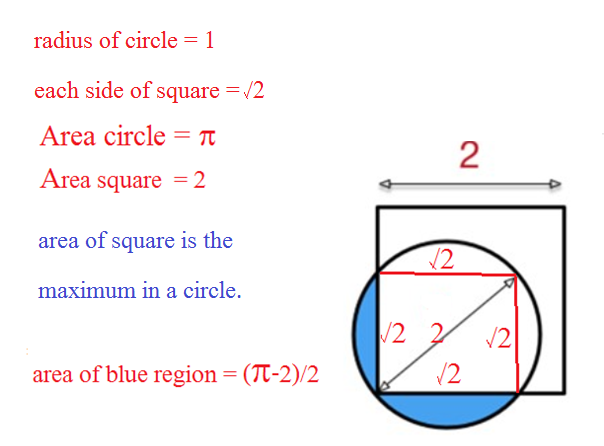Part of circle outside square!

The diagram above shows a circle of diameter 2 touching a vertex of a square of width 2.
Find the minimum possible area of the region of the circle that falls outside of the square.
This section requires Javascript.
You are seeing this because something didn't load right. We suggest you, (a) try
refreshing the page, (b) enabling javascript if it is disabled on your browser and,
finally, (c)
loading the
non-javascript version of this page
. We're sorry about the hassle.
3 solutions
Moderator note:
Good explanation of how to account for the area of the circle that's contained in the square, and thereby to calculate the max/min of the area.
You made a typing error in expression of K, value of r is 2/2 and it is written 2/1.
I have a slightly different solution. You already demonstrate that C A is a diameter of the circle. So the area of the triangle A B C is 2 2 × h where h is the height from B .
The minimum blue area will be when the triangle ABC has the maximum area, and that is when h is the maximum. That is, when B C = A B and h = 1 (the radius).
So, the minimum blue area is:
2 π × r 2 − 2 C A × h
2 π − 2 2 × 1
2 π − 2
Log in to reply
The minimum blue area will be when the triangle ABC has the maximum area, and that is when h is the maximum.
Yea, you need to prove that this is true. It sounds intuitive, but proving it requires some work as well.
Why don't you post a separate solution yourself?
this is my way,,,,
CA is a diameter (Because angle <CBA = 90º)
Blue area = Half Cercle - Triangle ABC = pi/2 - CA*h/2 = pi/2 - h, with h<=1
Blue area is minimum when when h=1, Minimum Blue Area = pi/2 -1

Let A , B and C be the points as shown below.
Because ∠ C B A represents an interior of a square, then ∠ C B A is a right angle, 9 0 ∘ .
Draw a straight line from point A to C , we have a right triangle A B C inscribed inside a circle. By Thales Theorem , the straight line C A represents the diameter of the circle.
For simplicity sake, let a and b denote the lengths A B and B C respectively. Then by Pythagorean theorem , a 2 + b 2 = 2 2 = 4 , where a , b > 0 .
And the area of the shaded region can be found by finding the difference between the areas of the semicircle that passes through the points C , B , A and the right triangle C B A . Let K denote the area of this shaded region, we have
K = 2 1 π r 2 − 2 1 ⋅ a b = 2 1 π ⋅ ( 2 2 ) 2 − 2 1 a b = 2 1 ( π − a b ) .
Since a and b represents two positive real numbers satisfying a 2 + b 2 = 4 as shown above, and we want to minimize K = 2 1 ( π − a b ) , this motivates me to find a relationship between a 2 + b 2 and a b , hence the use of power mean inequality :
2 a 2 + b 2 2 4 2 − a b K = 2 π − a b ≥ ≥ ≥ ≥ ≥ a b a b a b − 2 2 π − 2
Thus the minimum value of K (the area of the shaded region) is 2 π − 2 , and it occurs when a = b = 2 2 = 2 .